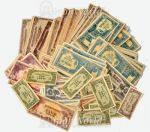We've tried to ensure the information displayed here is as accurate as possible. Should there be any inaccuracies, we would be grateful if you could let us know at info@ipohworld.org . All images and content are copyright.
(Please click on the thumbnail for a bigger image.)
A Collection Of Japanese Banana Money


The Japanese government-issued dollar was a form of currency issued by Imperial Japan during the Japanese occupation of Singapore, Malaya, North Borneo, Sarawak, and Brunei between 1942 and 1945. The currency was also referred informally (and with more than a trace of contempt) as banana money (Malay: duit pisang), named as such because of the motifs of banana trees on 10 dollar banknotes. The Japanese dollar was in widespread use within the occupied territories where the previous currency became a scarcity. The currency were referred to as "dollars" and "cents" like its predecessors, the Straits dollar and Malayan dollar.
The first series of notes were originally of lower denominations of 1, 5 and 10 dollars, issued in 1942. Each bear different obverse and reverse designs but retain similar layouts, with the obverse illustrating plantation crops. Additional 10 dollar notes were printed in 1944.
In September 1942, non-serialised currency notes were issued in denominations of 1, 5, 10 and 50 cents as a response to a shortage of old coins. The cent notes were of a simpler design, lacking plantation crops on the obverse; the 50 cent note is an exception. The cent notes are noticeably smaller than dollar notes.
Worsened economic conditions in the following years forced the Japanese government to begin printing notes of larger denominations of 100 and 1,000 dollars in 1944. The 100 dollar notes were printed in two dramatically different versions, while the 1,000 dollar note were available in only one version. Illustration on the notes center more around images of rural life. The 100 and 1,000 dollar notes were the last new notes introduced before the surrender of Imperial Japan in August 1945.
These batches of notes are examples of those available and are used for exhibition displays.